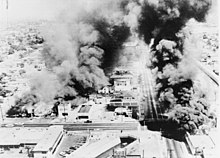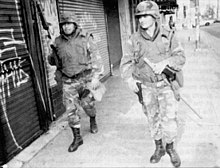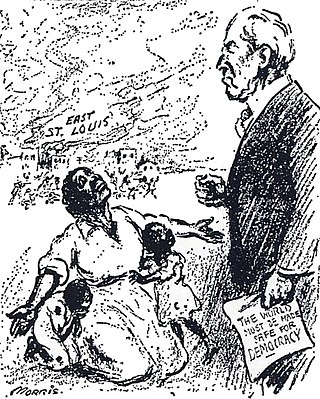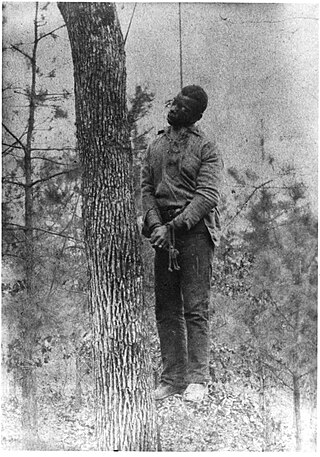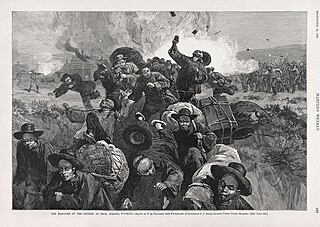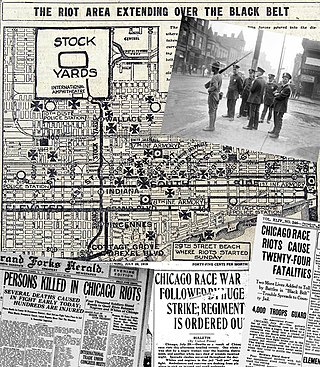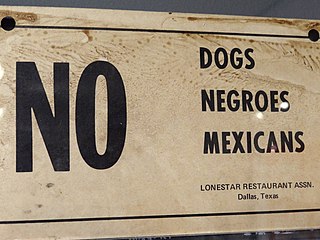History
Racial and ethnic cleansing
Racial and ethnic cleansing was committed on a large scale after the end of the American revolution during the early period of time in the history of the United States, particularly against American indians, who were forced off their lands and relocated to reservations. Along with them, Chinese Americans in the Pacific Northwest and African Americans throughout the United States (particularly in the American south) were rounded up and expunged from towns under threat of mob rule, the white mobs frequently intended to harm their African American targets. [1]
Genocide of California's Indigenous peoples
Following California's transition to statehood, the California state government, incited, [2] aided and financed miners, settlers, ranchers and people's militias to enslave, kidnap, or murder a major proportion of California’s Indigenous people, who were sometimes contemptuously referred to as "Diggers", for their practice of digging up roots to eat. [3] [4] [5] [6] [7] [8] [9] California governor Peter Hardeman Burnett predicted in 1851: "That a war of extermination will continue to be waged between the two races until the Indian race becomes extinct, must be expected. While we cannot anticipate the result with but painful regret, the inevitable destiny of the race is beyond the power and wisdom of man to avert." [2]
California state forces, private militias, Federal reservations, and sections of the US Army all participated in the campaign that caused the deaths of many California Indians with the state and federal governments paying millions of dollars to militias to murder Indians, [10] [11] while many starved on Federal Reservations because of their caloric distribution reducing from 480–910 to 160–390 [10] and between 1,680 and 3,741 California Indians were killed by the U.S. Army themselves. Between 1850 and 1852 the state appropriated almost one million dollars for the activities of militias, and between 1854 and 1859 the state appropriated another $500,000, almost half of which was reimbursed by the federal government. [12] Guenter Lewy, famous for the phrase "In the end, the sad fate of America's Indians represents not a crime but a tragedy, involving an irreconcilable collision of cultures and values" wrote that what happened in California may constitute genocide: "some of the massacres in California, where both the perpetrators and their supporters openly acknowledged a desire to destroy the Indians as an ethnic entity, might indeed be regarded under the terms of the convention as exhibiting genocidal intent." [13]
By one estimate, at least 4,500 California Indians were killed between 1849 and 1870. [14] Contemporary historian Benjamin Madley has documented the numbers of California Indians killed between 1846 and 1873; he estimates that during this period at least 9,400 to 16,000 California Indians were killed by non-Indians. Most of the deaths took place in what he defined as more than 370 massacres (defined as the "intentional killing of five or more disarmed combatants or largely unarmed noncombatants, including women, children, and prisoners, whether in the context of a battle or otherwise"). [15] Professor Ed Castillo, of Sonoma State University, estimates that more were killed: "The handiwork of these well armed death squads combined with the widespread random killing of Indians by individual miners resulted in the death of 100,000 Indians in the first two years of the gold rush." [16]
Numerous books have been written on the subject of the California Indian genocide, such as Genocide and Vendetta: The Round Valley Wars in Northern California by Lynwood Carranco and Estle Beard, Murder State: California's Native American Genocide, 1846–1873 by Brendan C. Lindsay, and An American Genocide: The United States and the California Indian Catastrophe, 1846–1873 by Benjamin Madley among others. Madley's book caused California governor Jerry Brown to recognize the genocide. [11] In a speech before representatives of Native American peoples in June, 2019, California governor Gavin Newsom apologized for the genocide. Newsom said, "That's what it was, a genocide. No other way to describe it. And that's the way it needs to be described in the history books." [17]
Anti-immigrant violence
Riots which are defined by "race" have taken place between ethnic groups in the United States since at least the 18th century and they may have also occurred before it. During the early-to-mid- 19th centuries, violent rioting occurred between Protestant "Nativists" and recently arrived Irish Catholic immigrants. [18]
The San Francisco Vigilance Movements of 1851 and 1856 have been described as responses to rampant crime and government corruption. But, since the late 19th century, historians have noted that the vigilantes had a nativist bias; they systematically attacked Irish immigrants, and later, they attacked Mexicans and Chileans who came as miners during the California Gold Rush, as well as Chinese immigrants. [19] During the early 20th century, whites committed acts of racial or ethnic violence against Filipinos, Japanese, and Armenians, all of whom had arrived in California during waves of immigration. [20]
During the late 19th and early 20th centuries, Italian immigrants were subjected to racial violence. In 1891, eleven Italians were lynched by a mob of thousands in New Orleans. [21] In the 1890s, a total of twenty Italians were lynched in the South. [22]
Reconstruction era (1863–1877)
As the American Civil War, ended, antislavery political forces demanded rights for ex-slaves. This led to the passage of the 14th and 15th amendments, which theoretically granted African-American and other minority males equality and voting rights. Although the federal government originally stationed troops in the South in order to protect these new freedoms, this time of progress was cut short. [23] [24]
By 1877, the North had lost its political will in the South and while slavery was gone, Jim Crow laws erased most of the freedoms which were guaranteed by the 14th and 15th amendments. Through violent economic tactics and legal technicalities, were gradually removed from the voting process. [25]
Lynching era and race riots (1878–1939)


Lynching is defined as “a form of violence in which a mob, under the pretext of administering justice without a trial, executes a presumed offender, often after inflicting torture and corporal mutilation on him or her.” [26] It was a particularly ritualistic form of murder, and it frequently involved the majority of the members of the local white community. Lynchings were sometimes announced in advance and they were frequently turned into spectacle lynchings which audiences could witness. The number of lynchings in the United States dropped from the 1880s to the 1920s, but there were still an average of about 30 lynchings per year during the 1920s. A study of 100 lynchings which was conducted from 1929 to 1940 revealed that at least one third of the victims were innocent of the crimes of which they were accused. [1]
Labor and immigrant conflicts were sources of tensions that served as catalysts for the East St. Louis riot of 1917. White rioters killed an between 39 and 150 Black residents of East St. Louis, after Black residents had killed two white policemen, mistaking the car which they were riding in for another car which was full of white occupants who previously drove through a Black neighborhood and randomly fired their guns into a crowd of Black people. Other White-on-Black race riots included the Atlanta riots (1906), the Omaha and Chicago riots (1919), some of a series of riots which occurred in the volatile post-World War I environment, and the Tulsa massacre (1921).
The Chicago race riot of 1919 grew out of tensions which existed on the Southside, where Irish Americans and Black residents were crowded into substandard housing and competed with each other for jobs at the stockyards. The Irish Americans had lived in the city for a longer period of time, and they also organized themselves around athletic and political clubs. Violence broke out across the city in late July. White mobs, many of which were organized around Irish athletic clubs, pulled black people off trolley cars, attacked Black businesses, and beat victims. City officials closed the street car system, but the rioting continued. A total of 23 Black people and 15 white people were killed. [27]
The 1921 Tulsa race massacre took place in Greenwood, which was a prosperous Black neighborhood in Tulsa, Oklahoma, home to around 10,000 Black residents and frequently called America's Black Wall Street. [28] The race riot was precipitated by 19-year-old Dick Rowland, a shoeshine accused of attacking 17-year-old white elevator operator Sarah Page at a department store, being arrested on May 31, 1921. [29] On June 1, a confrontation between Black and white groups outside the courthouse led to a shootout which killed 10 whites and 2 Blacks. The Black group then retreated back to the Greenwood District. [29] Subsequently, a white mob attacked Black businesses, homes, and residents in the Greenwood District. [30] The attack left over 35 city blocks burned, over 800 people injured, and between 100 and 300 people were killed. [29] Over 6,000 Black residents were also arrested by the Oklahoma National Guard, and taken to several internment centers. [29]
Civil rights era (1940–1971)
Though the Roosevelt administration, under tremendous pressure, produced anti-racist propaganda and helped push for African American employment in some cases, African Americans were still experiencing immense violence, particularly in the South. In March 1956, United States Senator Sam Ervin of North Carolina created the Southern Manifesto, [31] which promised to fight to keep Jim Crow alive by all legal means. [32]
This continuation of support for Jim Crow and segregation laws led to protests in which many African-Americans were violently injured out in the open at lunchroom counters, buses, polling places and local public areas. These protests did not eviscerate racism, but they prevented racism from being expressed out in the open and forced it to be expressed in more coded or metaphorical linguistic terms. [32]
By the 1960s, decades of racial, economic, and political forces, which generated inner city poverty, resulted in race riots within minority areas in cities across the United States. The beating and rumored death of cab driver John Smith by police, sparked the 1967 Newark riots. This event became, per capita, one of the deadliest civil disturbances of the 1960s. The long and short term causes of the Newark riots are explored in depth in the documentary film Revolution '67 and many news reports of the times. The riots in Newark spread across the United States in most major cities and over 100 deaths were reported. Many inner city neighborhoods in these cities were destroyed. The April 1968 assassination of Martin Luther King Jr. in Memphis, Tennessee and the June assassination of Robert F. Kennedy in Los Angeles also led to nationwide rioting with similar mass deaths. During the same time period, and since then, numerous violent acts committed against African-American churches have been reported. [33]
Modern era (1972–present)
Today racial violence has changed dramatically, because openly violent acts of racism are less prevalent, but acts of police brutality and the mass incarceration of racial minorities are continuing to be major issues within the United States. The war on drugs [34] has been noted as a direct cause of the dramatic increase in the number of incarcerations in the nation's prison system, which has risen from 300,000 in 1980 to more than 2,000,000 in 2000, though it does not account for the disproportionately high African American homicide and crime rates, which peaked before the War on Drugs began. [35]
During the 1980s and '90s a number of riots occurred that were related to longstanding racial tensions between police and minority communities. The 1980 Miami riots were catalyzed by the killing of an African-American motorist by four white Miami-Dade Police officers. They were subsequently acquitted on charges of manslaughter and evidence tampering. Similarly, the six-day 1992 Los Angeles riots erupted after the acquittal of four white LAPD officers who had been filmed beating Rodney King, an African-American motorist. Khalil Gibran Muhammad, the Director of the Harlem-based Schomburg Center for Research in Black Culture has identified more than 100 instances of mass racial violence in the United States since 1935 and has noted that almost every instance was precipitated by a police incident. [36]
The Cincinnati riots of 2001 were caused by the killing of 19-year-old African-American Timothy Thomas by white police officer Stephen Roach, who was subsequently acquitted on charges of negligent homicide. [37] The 2014 Ferguson unrest occurred against a backdrop of racial tension between police and the Black community of Ferguson, Missouri in the wake of the police shooting of Michael Brown; similar incidents elsewhere such as the killing of Trayvon Martin sparked smaller and isolated protests. According to the Associated Press' annual poll of United States news directors and editors, the top news story of 2014 was police killings of unarmed Black people, including Brown, as well as the investigations and the protests afterward. [38] [39] During the 2017 Unite the Right rally, an attendee drove his car into a crowd of people protesting the rally, killing 32-year-old Heather D. Heyer and injuring 19 others, and was indicted on federal hate crime charges. [40]
In 2020, the police killing of Breonna Taylor and the murders of Ahmaud Arbery and George Floyd sparked racial unrest over systemic racism and police brutality against African Americans. Riots during the summer resulted in destruction of property, mass looting, monument removals, and incidences of violence by counter-protesters and police across the United States. [41] [42] The Trump administration condemned violence during the movement and responded by threatening to quell demonstrations, for which it drew criticism. In June, president Donald Trump threatened to use the military to disperse protesters by invoking the Insurrection Act of 1807. [43] Federal law enforcement agencies were eventually deployed to assist local authorities and protect public property in Washington, D.C. [44]

